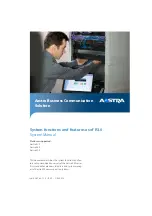
4. Disconnect the server from the power source.
Note:
After disconnecting all the power cords, wait approximately 15 seconds
for your system to stop running. Watch for the power-on LED on the front
of the server to stop flashing.
Standby mode
Standby mode refers to the condition in which the server operating system is not
running and all core logic is shut down except for the optional Remote Supervisor
Adapter. In Standby mode, the server can respond to ISMP requests, such as a
remote request to turn on the server. When the server is in Standby mode, the
power-on LED on the front of the server flashes (when the server is running, the
power-on LED stays on and does not flash).
You can put the server in Standby mode in any of the following ways:
v
You can press the power-control button on the server. This starts an orderly
shutdown of the operating system, if this feature is supported by your operating
system.
v
If the server is connected to an ASM interconnect network that contains at least
one system with an optional Remote Supervisor Adapter installed, the server can
be placed in Standby mode from the Remote Supervisor Adapter user interface.
v
If an optional Remote Supervisor Adapter is installed in the server, the server can
be placed in Standby mode from the Remote Supervisor Adapter user interface.
Attention:
You must disconnect all the server power cords from the electrical
outlets to remove all power from the server.
Complete the following steps to put the server in Standby mode:
1. See the operating-system documentation for the proper procedure to shut down
the operating system.
Note:
Each operating system is different. Read all the documentation about
shutting down the operating system before continuing.
2. Press the power-control button on the front of the server.
Notes:
a. After you place the server in Standby mode, wait at least 5 seconds before
you turn on the server again.
b. You might need to press and hold the power-control button for more than 4
seconds to cause an immediate shutdown of the operating system and to
force it into Standby mode. You can use this feature if the operating system
stops functioning.
The ISMP can put the server in Standby mode as an automatic response to a
critical system failure. You can also put the server into Standby mode remotely by
means of an optional Remote Supervisor Adapter or through connection to an ASM
interconnect network.
12
IBM xSeries 255 Type 8685: User’s Guide
Summary of Contents for 8685 - eServer xSeries 255
Page 1: ...User s Guide xSeries 255 Type 8685...
Page 2: ......
Page 3: ...IBM xSeries 255 Type 8685 User s Guide SC32 P020 00...
Page 14: ...xii IBM xSeries 255 Type 8685 User s Guide...
Page 42: ...28 IBM xSeries 255 Type 8685 User s Guide...
Page 56: ...42 IBM xSeries 255 Type 8685 User s Guide...
Page 65: ......
Page 66: ...IBM Part Number 32P0200 Printed in the United States of America 32P 2...
















































